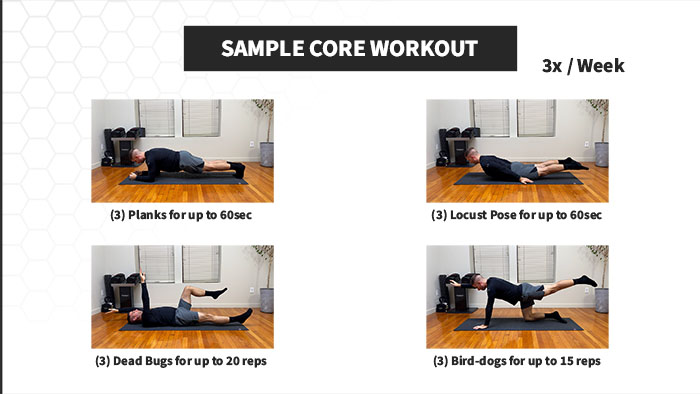Strong abdominal muscles help stabilize the trunk and unload lumbar spine stress [1]. This not only helps prevent lower back pain which is the number one cause of disability for people under 45 [2] but it can help improve posture and physical performance [3]. But more importantly, strong abdominal muscles provide you those 6-pack abs. Who cares about back pain, posture, or performance because what really matters is what our stomach looks like in the mirror right? Well, if that’s the case you’ll have much better luck reducing your body fat percentage down to around 10% as a male and 16% as a female because abs are built through exercise but more importantly revealed through nutrition [4]. Either way, a strong core will help with all these goals. But what muscles are in the core? What exercises does the science show best target and activate these muscles? And which exercises do doctors of physical therapy recommend most? Well, let’s get into it!
What is The Core?
Some people commonly refer to and mistake their superficial abdominals as their core. Others characterize all muscles between your pelvic floor and diaphragm as the core [5]. And some even consider all muscles attaching to the torso being the core [6]. So, while there isn’t a clear definition, I’m going to focus on the core muscles of the core. The core of the core. First, we have the three main local core muscles whose primary responsibility is stabilizing the core. This includes the transverse abdominis, internal obliques, and the multifidus. Second, we have the three main global core muscles whose primary responsibility is generating movement of the core. This includes the rectus abdominis, external obliques, and erector spinae [7]. There’s some overlap with these local and global muscles as they work together but these six core muscles are what we’re going to target today with the exercises to come.
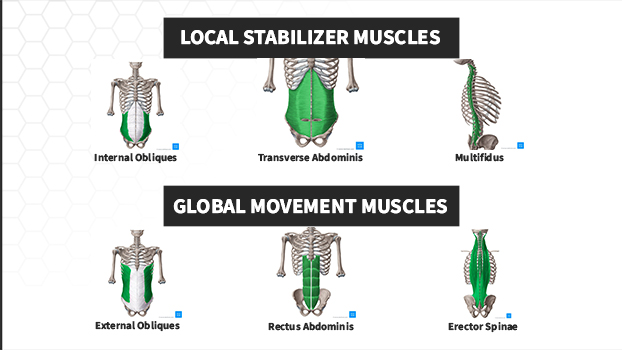
Now, when selecting exercises this means we not only want to choose core exercises that hit all six of these core muscles, but we also want exercises that target stabilization and movement. While movement-based core exercises like crunches and sit-ups are popular and important, it may be core muscle endurance, as opposed to maximal core strength, that is the primary factor of instability and lower back pain [8]. So, with all the anatomy covered, let’s get into four exercises you can use to obtain optimal core strength.
Plank
First, the front plank can be considered one of the most effective exercises in activating the abdominal and oblique stabilizers. You can perform a plank by laying down on your stomach. You’ll then place your forearms on the floor with your elbows underneath your shoulders. Finally, hold your spine and neck in a neutral position. At first, you may only be able to hold this position for 20 seconds but after a few days or weeks of practice, you should be able to get up to 60 second holds.

Now, this exercise can become easy with practice, so you’ll need to progress the exercise to continue challenging the muscles. Once you’re able to complete 60 second holds, shift your elbows forward to create a long-lever and posteriorly tilt your hips. This plank variation has been shown to elicit significantly greater muscle activity versus the traditional plank [8]. Once you can complete these for 60 seconds then you could look into narrowing your elbows to create more instability or adding weight onto your back as next progressions.
Locust Pose
Second, the locust pose can be considered one of the most effective exercises in activating the erector spinae and multifidus. You can perform a locust pose by laying down on your stomach. You’ll then place your arms by your side, palms down, and keep your legs together. Finally, you’ll lift your chest and legs off the ground by contracting your posterior muscles. At first, you may only be able to hold this position for 20 seconds but after a few days or weeks of practice, you should be able to get up to 60 second holds.
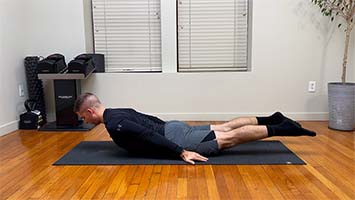
Like with the plank, this exercise can become easy with practice, so you’ll need to progress the exercise to continue challenging the muscles. Once you’re able to complete 60 second holds, shift your arms to a 70-degree angle like an airplane. This variation can make the locust pose more difficult. Once you can complete these for 60 seconds then you could look into holding onto very light dumbbells as a next progression.
Dead Bug
Now that we’ve performed two isometric exercises to target the local stabilizing muscles, let’s get into two dynamic exercises to target the global movement muscles. Third, the dead bug is an exercise I found to be one of the most recommended exercises by doctors and physical therapists. Dr. Michael Lau at Prehab considers this movement the best and most underutilized exercise [9]. You can perform dead bugs by laying down on your back. You’ll then reach your arms to the ceiling, palms facing your feet, and reach your legs to the ceiling with a 90-degree bend in the knees. Finally, you’ll lower the opposite arm and opposite leg to the floor slowly and return to the starting position. You’ll then perform the movement again with the alternate arm and leg. At first, you may only be able to do 6 repetitions on each side but after some practice, you should be able to get up to 20 repetitions on each side.
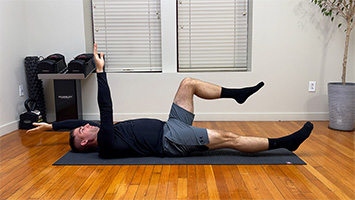
After you’re comfortably able to do three sets of 20 repetitions on each side, it’s time to progress the movement. You can progress the dead bug by reaching your arms higher towards the ceiling, so your head and shoulder blades remain off the floor. After that, you can look into reaching your hips slightly off the floor or holding onto light dumbbells as further progressions.
Bird Dog
Lastly, we’ll finish with another dynamic exercise that better targets the posterior muscles. The fourth exercise will be the bird dog which is one of Dr. Stuart McGill’s top three exercises for back health [10]. This exercise will look just like the dead bug exercise but flipped vertically. You can perform a bird dog by getting on your knees and hands in a quadruped position. Next, you’ll reach one arm overhead in alignment with your spine and straighten the opposite leg behind you in alignment with your spine. Finally, you’ll lower the opposite arm and leg to the floor slowly and return to the starting position. You’ll perform the movement again for up to 15 reps and then switch sides. At first, you may only be able to do 5 repetitions on each side but after some practice, you should be able to get up to 15 repetitions on each side.
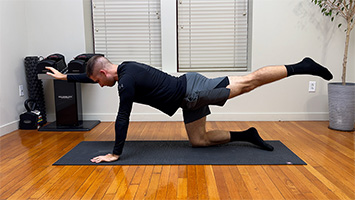
After you’re comfortably able to do three sets of 15 repetitions on each side, it’s time to progress the movement. You can progress the dead bug by adding an extra movement at the top of the extension. Once your opposite arm and opposite leg are fully raised, rotate the arm and leg out 45 degrees at the top of the extension and then bring it back to the neutral position. This added step increases its difficulty. As a final progression, you can lift both of your knees off the floor by an inch while performing the movement. By removing a point of contact from the floor, this will dramatically increase the instability of the exercise and the activation of your core musculature.
Final Thoughts
Strengthening your core is important for lower back health, improved posture, physical performance, and aesthetics. But it’s important we incorporate a variety of isometric and dynamic exercises to target both our local and global musculature systems. To do this, I’ve detailed four of the most researched and recommended core exercises that you can perform today without any equipment. Try performing three sets of each exercise three times a week and progress the movements slowly over time. These exercises performed over weeks and months will help you create a healthier and happier core.
